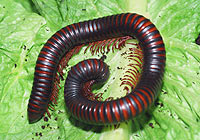Viewable


Millipede
Location at the Zoo
Malayan Woods
Global Range
Indomalaya
Asian giant millipede
Thyropygus spirobolinae sp.
Order: Spirostreptidae
Family: Harpagophoridae
Genus: Thyropygus
There are more than 10,000 described species of millipedes. Members of this group have three main body parts - the head, the body and the telson. On the head are the mouth parts, including mandibles and maxillae and sensory structures, including antennae and eyes. The head is generally heavily calcified to allow the animal to burrow. The body is long and cylindrical. Depending on the species, the surface may be smooth or covered with hairlike projections or bumps.
Millipedes are segmented, and each segment after the fourth bears two pairs of legs. The first segment, called the collum, is legless. The next three segments share three pairs of legs. The legs are on the ventral side of the animal and are S-shaped, which makes it appear as though the millipede is hanging from its legs rather than being supported by them. The telson is a preanal segment, preceded by one or more apodous segments (non-leg-bearing) where new segments will develop as the millipede moults and grows. Millipedes can be from 2 mm to 30 cm in length, and the largest recorded number of legs is 375 pairs (Illacme plenipes). Most millipedes are dull in appearance, although some tropical ones are brightly coloured. These millipedes (Spirobolinae.sp) are blue and red banded. The Asian giant millipede is a long cylindrical bulldozer, or rammer. It is the same width throughout its body length.
Males have gonopods which develop behind the seventh set of legs, after the moult of the fifth instar stage. These are the organs which transfer sperm to the female - she also has gonopods, but they are inside her body. The structure of the gonopods can help to identify specific species of millipedes. Males generally have longer legs and antennae than females.
Millipedes are segmented, and each segment after the fourth bears two pairs of legs. The first segment, called the collum, is legless. The next three segments share three pairs of legs. The legs are on the ventral side of the animal and are S-shaped, which makes it appear as though the millipede is hanging from its legs rather than being supported by them. The telson is a preanal segment, preceded by one or more apodous segments (non-leg-bearing) where new segments will develop as the millipede moults and grows. Millipedes can be from 2 mm to 30 cm in length, and the largest recorded number of legs is 375 pairs (Illacme plenipes). Most millipedes are dull in appearance, although some tropical ones are brightly coloured. These millipedes (Spirobolinae.sp) are blue and red banded. The Asian giant millipede is a long cylindrical bulldozer, or rammer. It is the same width throughout its body length.
Males have gonopods which develop behind the seventh set of legs, after the moult of the fifth instar stage. These are the organs which transfer sperm to the female - she also has gonopods, but they are inside her body. The structure of the gonopods can help to identify specific species of millipedes. Males generally have longer legs and antennae than females.
Distribution
While millipedes can be found in many habitats around the world, including caves, mountains, deserts, etc., almost all members of the order Spirobolida live in the tropics.Habitat
Asian giant millipedes prefer a hot and humid environment. In their native habitat, they dwell in leaf litter, topsoil, or rotting wood. Their many legs give them traction and power, and this allows them to use their heads to ‘bulldoze’ through the soil and litter.Diet
Most millipedes are detritivores, feeding on decomposing vegetation or organic matter. A very few species are omnivorous or carnivorous, preying on small arthropods, such as worms, insects, and centipedes. Many species have mouth parts similar to those of grasshoppers, and several species have piercing mouthparts that allow them to feed on plant juices. A millipede’s digestive tract is a simple tube with two pairs of salivary glands to help with digestion; some moisten their food with saliva before eating it. Micro-organisms help to break down plant fibres into smaller and more-easily digestible molecules like simple sugars.Reproduction
Male and female millipedes may be attracted to each other through pheromones (chemical signals). The female is passive during mating. The male runs up her back and uses the adhesive leg pads he has developed to hang on to her. He twists his front end around so that their ventral surfaces meet. He must fix the female's position and then he can transfer a sperm package directly from his gonopods into her genital opening. This can take minutes or hours, and may be repeated several times. Sometimes mating is prolonged if another male is present. Some mating behaviours include drumming, touching or rubbing.Females have their eggs tightly packed inside an ovitube. The eggs are passed forward singly for laying through the opening just behind her second pair of legs. There is a seasonal cycle to egg-laying, with the eggs released in the spring or early summer. Sperm is passed to the female during insemination in the mating procedure. She stores the sperm in special seminal receptacles in her body, and the eggs are only fertilized when they come into contact with the sperm as they are laid. The eggs contain lots of yolk to nourish the developing embryo, since this young animal will not begin to feed until after its second moult.
Females do not guard their eggs, but will try to give them some protection by digging a hole for them, covering them, or coating them with a special secretion that will protect them from changes in temperature and humidity. Hatching and development are slow. It can take up to 10 weeks for the young to emerge from their eggs. Temperature appears to play a role in hatching speed.
A legless pupoid larva hatches from the egg. During subsequent moults, the instar goes from having three or four pairs of legs and being blind to development of further sets of legs and eyes. By the third moult, the young have chewed a hole in the nest and emerged to begin feeding. Millipedes go through many moults over their lives. It is thought that up to 10 percent of their life from egg to adult is spent moulting. Moulting is synchronised to climatic conditions. Since this is their most vulnerable time, they seek shelter or build a moulting chamber for protection.
Moulting happens in four stages: the first stage is the preparation - burrowing into or building a shelter. Stage two is rigidation when the millipede lies on its side in a semi-circle. Its body lengthens as new growth pushes the old exoskeleton away. In stage three, the old exoskeleton splits (ecdysis) and the animal can walk out of it. Stage four is recovery for getting all parts in their proper place and hardening the outside. Generally the old exoskeleton is eaten. The entire process can take several weeks. Some species arrive at a maximum number of segments and do not moult again. Others continue to moult and add new segments even after they have reached sexual maturity. For invertebrates, millipedes are quite long-lived. Some take up to four years to reach maturity. Certain species can live to be 11 years of age. Some species of millipede can also reproduce parthenogenetically when males are scare or unavailable.
Adaptation
Millipedes have chemical defenses that are secreted from glands on the sides of their bodies via small pores that open with muscular movement when they are needed. Although not fatal, these secretions can cause discomfort and blindness to humans. Their exoskeleton protects them from many hazards.They are air-breathers, so most appear at the surface in water-logged soils in order not to drown. Some species can stay submerged for months by maintaining a sort of air bubble around their bodies. They are very susceptible to water loss, especially small millipedes since their bodies are typically 60 percent water. To prevent water loss, millipedes coil themselves and become more active at night when humidity is higher. During a seasonal drought, they can go dormant. They regulate their body temperatures by moving to areas of preferred temperature. They have a strong sense of direction and are able to follow chemical trails. Bodies are equipped with many different sensory receptors to enable them to survive in their environment - they respond to taste, temperature, humidity, and light levels. The antennae which are used to feel, smell, and taste have some powers of regeneration, and can re-grow if damaged.
They have double sets of legs to give them greater power at thrusting forward in order to burrow through their environment. Their calcified head capsules are like armour. This allows them to occupy habitats that are not available to other creatures.Millipedes seem to become the dominant detritivores in environments where earthworms are scarce.
Millipede exoskeletons contain calcium, and they are relatively hard. When threatened, most species curl up into a ball, relying on their shells for protection. Additionally, many animals such as ants and spiders do not eat millipedes because they have a series of defensive glands along both sides of their body. These glands give off defensive secretions of varying sorts, depending upon the species. The secretions are generally foul tasting and sometimes either poisonous or sedative in nature. Many millipedes are associated with ants. They have a mutualistic relationship, with the ants protecting the millipedes from predators and the millipedes keeping the ants' nests clean.
Threats to Survival
Since millipedes are slow movers, they have very limited dispersal abilities. Many different species have developed to fill all available niches within restricted ranges. This makes them vulnerable to even small environmental changes. The changes humans are making to the environment at such a fast pace could prove difficult for millipedes. Since pollution with some elements such as zinc, cadmium and lead has become an issue in many environments, millipedes which are sensitive to these poisons may find their food contaminated.Natural predators of millipedes include birds, reptiles like lizards, invertebrates like beetles, and some small mammals. Some glow worm species (Coleoptera) are millipede specialists and also assassin bugs specialize in millipedes. Millipedes are prey to a number of parasites, including some species of fungi, protozoa, nematodes, and worms. Many millipedes are seen with mites running over them, but scientists believe they do not harm their hosts. In some areas, millipedes have been known to swarm and invade cropland or even houses, making them a nuisance or pest.












